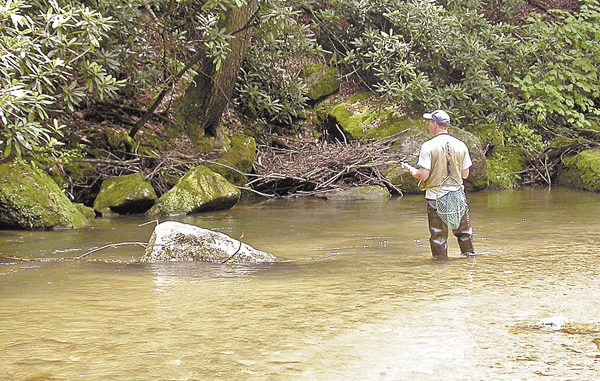
The two best trout-fishing seasons are spring and fall. In early spring, wildflowers poke out of winter leaf cover, and trees begin to bud. Hatches are abundant, and trout are feisty and hungry after the lean times of winter. Weather, though, can be a bit erratic. Temperatures can suddenly drop to the 30s, even in May.
While both seasons offer prime fishing, fall has the edge in terms of beauty and weather. Mountainsides are aglow with the golden yellows of poplars, the fiery oranges and reds of maples and the deep burgundies of oaks. Joe Pye weed, ironweed, asters, goldenrod and oxeye daisies brighten fields, pastures and roadsides in a dazzling array of colors: deep purple, pink, lavender, pale blue and bright yellow. Mountain peaks and ranges, once obscured by summer haze, stand out clear and distinct as far as the eye can see.
October weather is consistent: cool mornings, warm afternoons and cool evenings. Water temperatures have dropped, and trout are active, eating anything available, storing up fat for the winter.
Another big plus for fall fishing is that it’s spawn time for brown trout and brook trout. Females head for tributaries to lay their eggs, and males follow right behind to do their part in the reproduction cycle.
The spawning ritual for brown trout can begin as early as mid-September and continue into November, depending on weather and stream conditions.
Of the two species, the brown trout is the most visible and most active. The male brown trout’s colors, especially the distinctive red spots on its sides, become more vivid, and males develop a pronounced hook or kype in the lower jaw.
At the beginning of the cycle, adult female browns begin moving upstream, searching for likely places to spawn. During this period, brown trout feed heavily, building up strength and stamina for the mating ritual. The constant movement can continue for weeks since all brown trout do not spawn at the same time. They’re easy to find, easy to see and much easier to catch.
Large flies such as a Nos. 12 and 10 chartreuse, olive, or black Woolly Booger are especially effective for prespawn browns. Browns will hit Woolly Boogers because they think they’re salamanders. Other deadly flies are No. 10 Bitch Creek Nymphs and No. 12-10 Girdle Bugs. Spinning lures such as a quarter-ounce Mepps Aglia or a Panther Martin with a black body and yellow dots also work well on pre-spawn trout.
Females seek out the spawning sites; males merely follow to accommodate them. Once a female brown finds a suitable spawning site, she uses her tail to dig out a small depression, or redd, in a clean area free of silt and sand and with numerous pebbles. Browns prefer the tail-end of a run or riffle where water is shallow and flow is adequate to keep the redd oxygenated.
While the female does the work, the male waits patiently until the redd is prepared and the female is ready to deposit her eggs. When the female indicates she’s ready, the male joins her, and, side by side, backs arched, jaws open, they complete the ritual with the female depositing her eggs over the redd and the male emitting a cloud of semen. Using her tail again, the female covers the eggs with pebbles and small rocks, anywhere from a couple of inches to six inches deep. Females often build several redds to ensure propagation.
During the actual spawning, neither the male nor the female feeds. The male, however, will strike at something he thinks is a threat to the female or to her eggs. Once the eggs are laid and covered, the trout’s parental duties are over, and the eggs and subsequent fry are on their own. Eggs can survive even in below-zero temperatures, as long as the water doesn’t freeze, a rarity for high-gradient, southern Appalachian streams. Once eggs are laid and covered, they remain in the redd until spring, hatching usually between mid January and mid March. When fry are able to forage on their own, they abandon the redd.
Once spawning is completed, browns return to their former habitat. For post-spawn brown trout, egg patterns such as Glow Bugs are very effective because brown trout often eat the eggs and young of other trout.
Brook trout follow much the same patterns as browns, only the spawning begins later, usually mid-October through mid-November. Since wild brook trout are found in small streams, they don’t move as much or as far as browns.
As for catching either brook or brown trout during the spawning cycle, Mallory Martin, a fisheries biologist who is assistant executive director of the N.C. Wildlife Resources Commission, said angling activity does not adversely affect a spawn if a trout is not injured or played to exhaustion when it’s caught. When released, the trout will resume its spawning activities. The key word is “release.” Kill a spawning trout, and you’ve destroyed an entire generation of trout.
Best places to find larger brown trout during the spawning cycle are in the tributaries of large streams such as the Tuckasegee River, Nantahala River, the East Fork of the Pigeon River, South Toe River, and Davidson River. Just about any tributary of a large stream will attract spawning trout.
Tributaries that feed lakes also are prime spawning grounds for lake trout. Big browns from Lake Jocassee move up the Thompson River, Whitewater Rive, and Horsepasture River to spawn. Big browns from Davidson go up Cove Creek and Avery Creek. Trout from Fontana Reservoir spawn in Hazel Creek and smaller tributaries.
Other prime spawning grounds for big brown trout are the Oconaluftee River, Deep Creek, and Bradley Fork in the North Carolina section of the Great Smoky Mountains National Park, and Rocky Broad River near Lake Lure.
Fall in the mountains is indeed a magical time for trout
fishing.




Be the first to comment